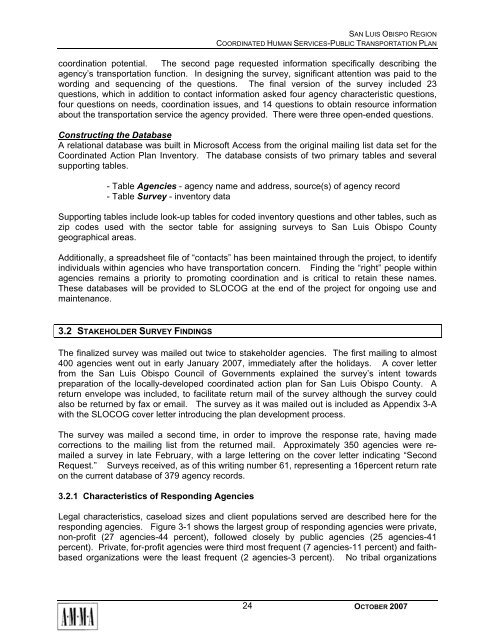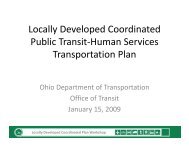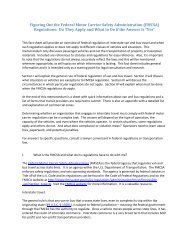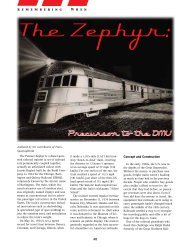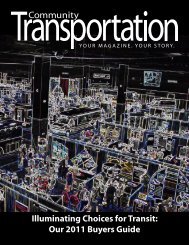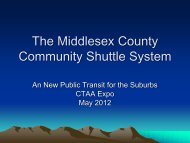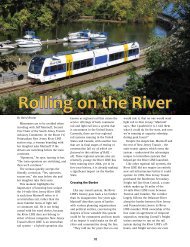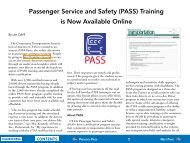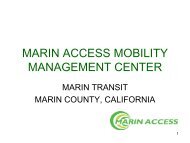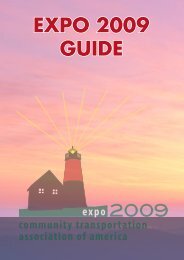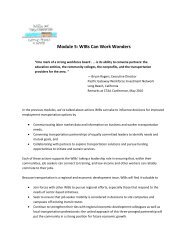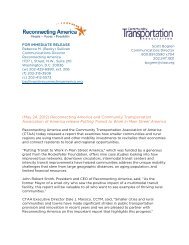San Luis Obispo - Caltrans - State of California
San Luis Obispo - Caltrans - State of California
San Luis Obispo - Caltrans - State of California
Create successful ePaper yourself
Turn your PDF publications into a flip-book with our unique Google optimized e-Paper software.
SAN LUIS OBISPO REGION<br />
COORDINATED HUMAN SERVICES-PUBLIC TRANSPORTATION PLAN<br />
coordination potential. The second page requested information specifically describing the<br />
agency’s transportation function. In designing the survey, significant attention was paid to the<br />
wording and sequencing <strong>of</strong> the questions. The final version <strong>of</strong> the survey included 23<br />
questions, which in addition to contact information asked four agency characteristic questions,<br />
four questions on needs, coordination issues, and 14 questions to obtain resource information<br />
about the transportation service the agency provided. There were three open-ended questions.<br />
Constructing the Database<br />
A relational database was built in Micros<strong>of</strong>t Access from the original mailing list data set for the<br />
Coordinated Action Plan Inventory. The database consists <strong>of</strong> two primary tables and several<br />
supporting tables.<br />
- Table Agencies - agency name and address, source(s) <strong>of</strong> agency record<br />
- Table Survey - inventory data<br />
Supporting tables include look-up tables for coded inventory questions and other tables, such as<br />
zip codes used with the sector table for assigning surveys to <strong>San</strong> <strong>Luis</strong> <strong>Obispo</strong> County<br />
geographical areas.<br />
Additionally, a spreadsheet file <strong>of</strong> “contacts” has been maintained through the project, to identify<br />
individuals within agencies who have transportation concern. Finding the “right” people within<br />
agencies remains a priority to promoting coordination and is critical to retain these names.<br />
These databases will be provided to SLOCOG at the end <strong>of</strong> the project for ongoing use and<br />
maintenance.<br />
3.2 STAKEHOLDER SURVEY FINDINGS<br />
The finalized survey was mailed out twice to stakeholder agencies. The first mailing to almost<br />
400 agencies went out in early January 2007, immediately after the holidays. A cover letter<br />
from the <strong>San</strong> <strong>Luis</strong> <strong>Obispo</strong> Council <strong>of</strong> Governments explained the survey’s intent towards<br />
preparation <strong>of</strong> the locally-developed coordinated action plan for <strong>San</strong> <strong>Luis</strong> <strong>Obispo</strong> County. A<br />
return envelope was included, to facilitate return mail <strong>of</strong> the survey although the survey could<br />
also be returned by fax or email. The survey as it was mailed out is included as Appendix 3-A<br />
with the SLOCOG cover letter introducing the plan development process.<br />
The survey was mailed a second time, in order to improve the response rate, having made<br />
corrections to the mailing list from the returned mail. Approximately 350 agencies were remailed<br />
a survey in late February, with a large lettering on the cover letter indicating “Second<br />
Request.” Surveys received, as <strong>of</strong> this writing number 61, representing a 16percent return rate<br />
on the current database <strong>of</strong> 379 agency records.<br />
3.2.1 Characteristics <strong>of</strong> Responding Agencies<br />
Legal characteristics, caseload sizes and client populations served are described here for the<br />
responding agencies. Figure 3-1 shows the largest group <strong>of</strong> responding agencies were private,<br />
non-pr<strong>of</strong>it (27 agencies-44 percent), followed closely by public agencies (25 agencies-41<br />
percent). Private, for-pr<strong>of</strong>it agencies were third most frequent (7 agencies-11 percent) and faithbased<br />
organizations were the least frequent (2 agencies-3 percent). No tribal organizations<br />
24<br />
OCTOBER 2007


